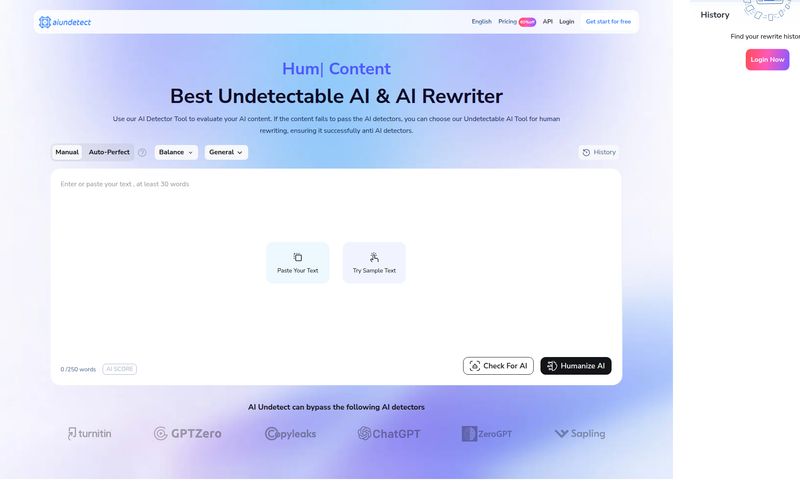I’ve been down this road a thousand times. You probably have, too. The endless, all-consuming search for the perfect note-taking app. You know the one. It’s a unicorn. It has the power of Notion, the beautiful simplicity of iA Writer, and the privacy of a leather-bound journal locked in a safe. We're all chasing this mythical beast in the great productivity app wars.
So, when a new contender called Inke popped up on my radar, my curiosity was piqued. The promise? An AI-powered markdown editor with real-time collaboration and... wait for it... local data storage. That last one got my attention. It’s a direct nod to the growing chorus of us who are a little tired of our entire digital lives being held hostage on someone else's server.
My journey to check out Inke started, quite literally, with a dead end. A big, fat, gray 404 page. Not the most inspiring start, I'll admit. But as anyone in the tech world knows, sometimes a 404 just means you're early to the party. So I dusted myself off and kept digging.
First Impressions and That Awkward 404
There's a certain thrill to finding a new tool before it hits the mainstream. You feel like a digital pioneer. But when the first thing you see is a 'Not Found' error, that pioneering spirit takes a small hit. It's the digital equivalent of showing up to a restaurant you've heard great things about, only to find the doors boarded up.
But hey, I'm a professional. I've seen more 404s than I've had hot dinners. It often just signals a product that’s brand new, maybe still moving things around, or a team that’s more focused on the product than their marketing pages. I can respect that. After a bit more searching, I found my way in, and I'm glad I did. The idea behind Inke is genuinely compelling.

Visit Inke
What Exactly is Inke Supposed to Be?
So, past the initial digital rubble, what is Inke? At its core, it's a web-based editor that's fluent in Markdown—that simple, text-based syntax that writers and developers have come to adore. But it’s not just another blank page. Inke is trying to build a bridge between two very different worlds.
On one side, you have the collaborative, cloud-native giants like Google Docs or Notion, where everything is online, all the time. Super convenient for teams, but your data is perpetually out of your hands. On the other side, you have the privacy-first, local-storage champions like Obsidian, which are powerful and secure but can sometimes feel a bit isolated and technically demanding for the average user.
Inke is trying to plant its flag right in the middle of that divide. It offers the modern bells and whistles—AI assistance and real-time collaboration—but with a foundational respect for data ownership by keeping your notes on your own machine first. It's a bold idea, and one I think has a lot of potential.
The Features That Actually Matter
Let's get into the nitty-gritty. A cool concept is one thing, but execution is everything. Inke hangs its hat on a few key features that are worth a closer look.
The AI Writing Assistant
It's 2024, if your new text editor doesn't have an AI assistant, does it even exist? Inke is no exception. It has the expected suite of AI tools: continue writing, editing and rephrasing, translating, and even a chat function to brainstorm ideas. It's becoming table stakes, but having it integrated directly into your writing environment is undeniably useful for breaking through writer's block or just polishing up some sloppy copy. This isn't some groundbreaking AI, but its integration is smooth. It’s there when you need it, and unobtrusive when you don’t.
Local Storage is the Real Hero
For me, this isn't just a feature; it's the main event. The philosophy of local-first software is gaining so much traction because people are tired of the risks associated with cloud-only services. We've all heard the horror stories of a service shutting down and users scrambling to export decades of data. Inke's approach—saving your notes to your local device by default—is a massive breath of fresh air. It gives you, the user, the ultimate control. You can still upload notes to their cloud for syncing and sharing, but the default is privacy and ownership. I love this. Its a fundamental shift in the power dynamic between user and platform.
Real-Time Collaboration and Markdown Goodness
Marrying Markdown with real-time collaboration is tricky. Markdown is for individualists, collaboration is for teams. Inke aims to make it work. You get the clean, distraction-free writing experience of Markdown, with the ability for multiple people to jump into a document and edit together. This could be huge for teams of writers, developers working on documentation, or marketing teams drafting copy. It lowers the barrier to entry for collaboration without forcing everyone into a clunky, proprietary rich-text editor.
Let's Talk About the Pricing (or Lack Thereof)
Okay, this is where things get... interesting. When I landed on the Inke pricing page, I had to double-check I was reading it correctly. As of right now, every single tier is listed as $0. Yes, free.
Now, we in the SEO and tech world know there's no such thing as a free lunch. The "cost" comes in the form of limitations. Here’s a quick breakdown:
| Plan | Cloud Notes | Daily AI Generations | Image Upload Limit | Cost & Status |
|---|---|---|---|---|
| Free | 20 | 100 | < 1MB | $0 / Sign in |
| Basic | Unlimited | 300 | < 1MB | $0 / Apply for free |
| Pro | Unlimited | 1000 | < 10MB | $0 / Coming soon |
This pricing structure screams "beta phase." They're likely trying to attract a user base to gather feedback before rolling out paid plans. The "Apply for free" for the Basic tier and "Coming soon" for Pro confirms this. It’s a smart strategy, but one potential users should be aware of. The free tier is a decent taster, but the 20-note cloud limit and the tiny 1MB image upload size are real constraints.
The Good, The Bad, and The Quirky
So, should you jump on the Inke bandwagon? Let's break it down without the boring pros and cons list.
What’s genuinely great is the core philosophy. Local-first storage with optional cloud sync is the future, in my opinion. The multiple export options (PDF, image, MD, JSON) are also incredibly practical for anyone who needs to move their work between different platforms. And you can't argue with free entry.
On the flip side, the limitations are... limiting. The restrictions on the free plan, especially for image uploads, feel a bit punishing. And the general vibe, from the 404s to the "coming soon" pricing, is that this is a product that is still finding its feet. It lacks the robust plugin ecosystem and community that powerhouses like Obsidian have built over years. It’s not quite ready to take on the giants.
Who is Inke Actually For?
I see a few perfect users for Inke in its current state.
- The Privacy-Conscious Writer: If you love the idea of Obsidian but find it a bit too complex, Inke offers a more streamlined, web-based alternative with that all-important local storage.
- The Agile Team on a Budget: For small teams needing a collaborative Markdown editor for drafting docs or copy, Inke is a risk-free way to get started without a hefty subscription fee.
- The Curious Tool-Hopper: If you’re like me and you love trying new productivity apps, Inke is a fascinating experiment in blending privacy with modern features.
Who is it probably not for? Power users who rely on extensive integrations and automations. It's not a project management tool and it won't replace your entire Notion setup... at least not yet.
Frequently Asked Questions about Inke
- What is Inke?
- Inke is a web-based markdown editor that combines AI-powered writing assistance and real-time collaboration with a local-first storage approach, meaning your data is saved on your device by default for enhanced privacy.
- Is Inke really free?
- Currently, all its tiers (Free, Basic, Pro) are listed at $0, but with different limitations on features like cloud storage, AI usage, and file uploads. This suggests it's in a beta or introductory phase, and paid plans may be introduced later.
- How does the local storage work?
- Inke saves your notes directly to your computer's storage first. This ensures you always have access to and control over your files, even offline. You can then choose to upload specific notes to their cloud to sync between devices or collaborate with others.
- Can I use Inke for team collaboration?
- Yes, it has real-time collaboration features, allowing multiple users to edit a document simultaneously, making it suitable for teams of writers, developers, or marketers.
- What are the main limitations of the free version?
- The primary limitations on the entry-level Free tier are a cap of 20 notes that can be uploaded to the cloud, a 100-per-day limit on AI generations, and a very small image upload size of less than 1MB.
- Is Inke a good alternative to Notion or Obsidian?
- It's more of a middle-ground. It's simpler and more privacy-focused than Notion, but less customizable and powerful than Obsidian. It's a good alternative for those who want a blend of features from both without the extremes of either platform.
My Final Verdict on Inke
Inke is a promising, if slightly awkward, newcomer. The foundation is solid rock. The combination of a clean Markdown editor, useful AI, and a genuine commitment to local-first data is a recipe for success. It feels like a tool built for the modern writer who values both convenience and control.
Yes, it's still a bit raw around the edges. My journey with it literally started with an error page. But I’m not writing it off. Far from it. I’m adding Inke to my personal 'watch list' of tools with serious potential. Sometimes the most interesting paths start with a wrong turn, and I have a feeling Inke is a journey worth following. I'm genuinely curious to see where it goes from here.
Reference and Sources
- Inke Official Pricing Page
- Learn more about the Local-First Software movement
- Obsidian - A popular local-first knowledge base



